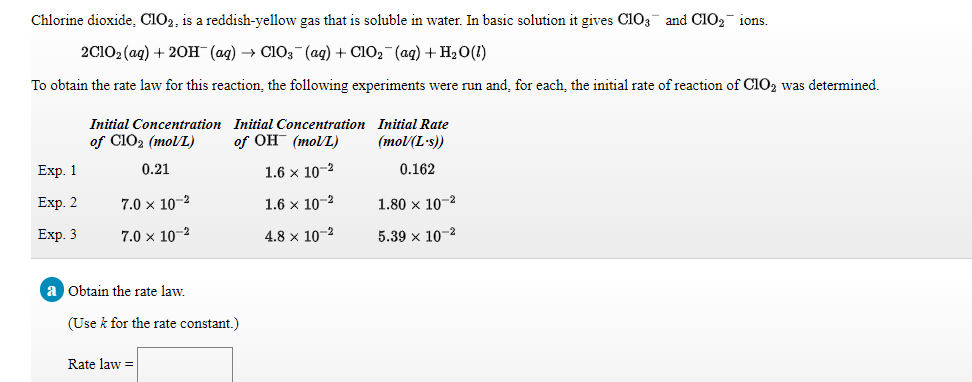Chlorine dioxide, Cl02, is a reddish-yellow gas that is soluble in water. In basic solution it gives Cl03 and Cl02 ions. 2C102 (ag) + 20H (ag) → ClO3 (ag) + C1O2¯(aq) + H20(1) To obtain the rate law for this reaction, the following experiments were run and, for each, the initial rate of reaction of C102 was determined. Initial Concentration Initial Concentration Initial Rate of C102 (mol/L) of OH (mo/L) (тol (L-)) Exp. 1 0.21 1.6 x 10-2 0.162 Exp. 2 7.0 × 10-2 1.6 x 10-2 1.80 x 10-2 Exp. 3 7.0 x 10-2 4.8 × 10-2 5.39 x 10-2 a Obtain the rate law. (Use k for the rate constant.) Rate law =
Chlorine dioxide, Cl02, is a reddish-yellow gas that is soluble in water. In basic solution it gives Cl03 and Cl02 ions. 2C102 (ag) + 20H (ag) → ClO3 (ag) + C1O2¯(aq) + H20(1) To obtain the rate law for this reaction, the following experiments were run and, for each, the initial rate of reaction of C102 was determined. Initial Concentration Initial Concentration Initial Rate of C102 (mol/L) of OH (mo/L) (тol (L-)) Exp. 1 0.21 1.6 x 10-2 0.162 Exp. 2 7.0 × 10-2 1.6 x 10-2 1.80 x 10-2 Exp. 3 7.0 x 10-2 4.8 × 10-2 5.39 x 10-2 a Obtain the rate law. (Use k for the rate constant.) Rate law =
Chemistry by OpenStax (2015-05-04)
1st Edition
ISBN:9781938168390
Author:Klaus Theopold, Richard H Langley, Paul Flowers, William R. Robinson, Mark Blaser
Publisher:Klaus Theopold, Richard H Langley, Paul Flowers, William R. Robinson, Mark Blaser
Chapter12: Kinetics
Section: Chapter Questions
Problem 43E: Some bacteria are resistant to the antibiotic penicillin because they produce penicillinase, an...
Related questions
Question

Transcribed Image Text:Chlorine dioxide, Cl02, is a reddish-yellow gas that is soluble in water. In basic solution it gives Cl03- and CIO2 ions.
2C1O:(aq) + 20н (ад) —> СIО3 (aд) + CIO, (aq) + H;0(1)
To obtain the rate law for this reaction, the following experiments were run and, for each, the initial rate of reaction of ClO2 was determined.
Initial Concentration Initial Concentration Initial Rate
of Cl02 (mol/L)
of OH (mol/L)
(mol(L's)
Exp. 1
0.21
1.6 x 10-2
0.162
Exp. 2
7.0 x 10-2
1.6 x 10-2
1.80 x 10-2
Exp. 3
7.0 x 10-2
4.8 x 10-2
5.39 х 10-2
a Obtain the rate law.
(Use k for the rate constant.)
Rate law =
Expert Solution
This question has been solved!
Explore an expertly crafted, step-by-step solution for a thorough understanding of key concepts.
This is a popular solution!
Trending now
This is a popular solution!
Step by step
Solved in 2 steps

Knowledge Booster
Learn more about
Need a deep-dive on the concept behind this application? Look no further. Learn more about this topic, chemistry and related others by exploring similar questions and additional content below.Recommended textbooks for you

Chemistry by OpenStax (2015-05-04)
Chemistry
ISBN:
9781938168390
Author:
Klaus Theopold, Richard H Langley, Paul Flowers, William R. Robinson, Mark Blaser
Publisher:
OpenStax

Chemistry: The Molecular Science
Chemistry
ISBN:
9781285199047
Author:
John W. Moore, Conrad L. Stanitski
Publisher:
Cengage Learning

Chemistry & Chemical Reactivity
Chemistry
ISBN:
9781133949640
Author:
John C. Kotz, Paul M. Treichel, John Townsend, David Treichel
Publisher:
Cengage Learning

Chemistry by OpenStax (2015-05-04)
Chemistry
ISBN:
9781938168390
Author:
Klaus Theopold, Richard H Langley, Paul Flowers, William R. Robinson, Mark Blaser
Publisher:
OpenStax

Chemistry: The Molecular Science
Chemistry
ISBN:
9781285199047
Author:
John W. Moore, Conrad L. Stanitski
Publisher:
Cengage Learning

Chemistry & Chemical Reactivity
Chemistry
ISBN:
9781133949640
Author:
John C. Kotz, Paul M. Treichel, John Townsend, David Treichel
Publisher:
Cengage Learning

Chemistry & Chemical Reactivity
Chemistry
ISBN:
9781337399074
Author:
John C. Kotz, Paul M. Treichel, John Townsend, David Treichel
Publisher:
Cengage Learning

Principles of Modern Chemistry
Chemistry
ISBN:
9781305079113
Author:
David W. Oxtoby, H. Pat Gillis, Laurie J. Butler
Publisher:
Cengage Learning

Chemistry
Chemistry
ISBN:
9781305957404
Author:
Steven S. Zumdahl, Susan A. Zumdahl, Donald J. DeCoste
Publisher:
Cengage Learning